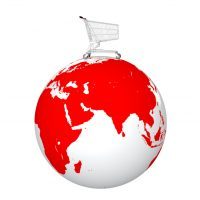 Decades ago following World War II, these United States were about the only part of the globe left without major damage to the industrial infrastructure. With it and the workforce remaining, we were blessed to be able to produce a fantastic amount of everything known to man and send it overseas to help rebuild Europe and Asia as well as feed millions at the same time. Industrially, the late 1940’s and 1950’s were the good old days for us.
Decades ago following World War II, these United States were about the only part of the globe left without major damage to the industrial infrastructure. With it and the workforce remaining, we were blessed to be able to produce a fantastic amount of everything known to man and send it overseas to help rebuild Europe and Asia as well as feed millions at the same time. Industrially, the late 1940’s and 1950’s were the good old days for us.
Consequently, we were also the elephant in the investment pool. Most of that productivity occurred through US corporations and the rest of the world could have been viewed as Emerging Markets at least temporarily. The powerhouse countries of Europe and Asia recovered with our help and began to compete with us to produce everything known to man. Their corporations and stock markets were often on different trending cycles and investing part of our money became a safety-through-global-diversification concept.
Fast forward to today. I wonder if there is such a thing as a local public corporation in any nation. Every country is selling to everyone else globally. If a company is not, it had better be running scared since there are competitors trying to set up shop somewhere else with labor or resource advantages. As Satchel Paige said, “Don’t look back because they may be gaining on you!”
Due to shortages of time and ink—(joke intended), I will skip to the conclusion. After all of the strange effects of zero interest rates in the US, and now, negative interest rates in other lands far away, the international stock markets have lagged quite a bit. The US has attracted money into our markets as others offshore have feared for their local financial health conditions.
There are many great sayings that characterize the stock market. One that repeats itself more than any other I’ve observed is that the stock market is a mean reversion machine. This influx of cash to our markets has pushed large cap equites up to around their long run average. This after being about 50 percent below it in 2008. The subsequent outflow of money from foreign equites has depressed their equity returns to around 35 percent below their long run average.
Great opportunity then exists in foreign equities should they eventually revert back up towards their average long term return rates. Past occasions when trading this far below their averages has led to annualized returns that can make any investor swoon.
International equities may not jolt upwards tomorrow, but eventually the terrible news forces the last towel to be thrown. It doesn’t take great news to make them turn either. It can simply be headlines that aren’t as terrible as the previous one.
It isn’t easy to take the plunge. Very few people felt good about buying our markets at the depths of despair in 2008 and beyond. I can’t help but wonder if a similar situation is presenting itself now with foreign equites.
(Discussion of historical trends from RiverFront Investment Group www.riverfrontig.com. RiverFront and Stewardship Capital are unaffiliated. Past performance is no guarantee of future results. Advice is intended to be general in nature.)
